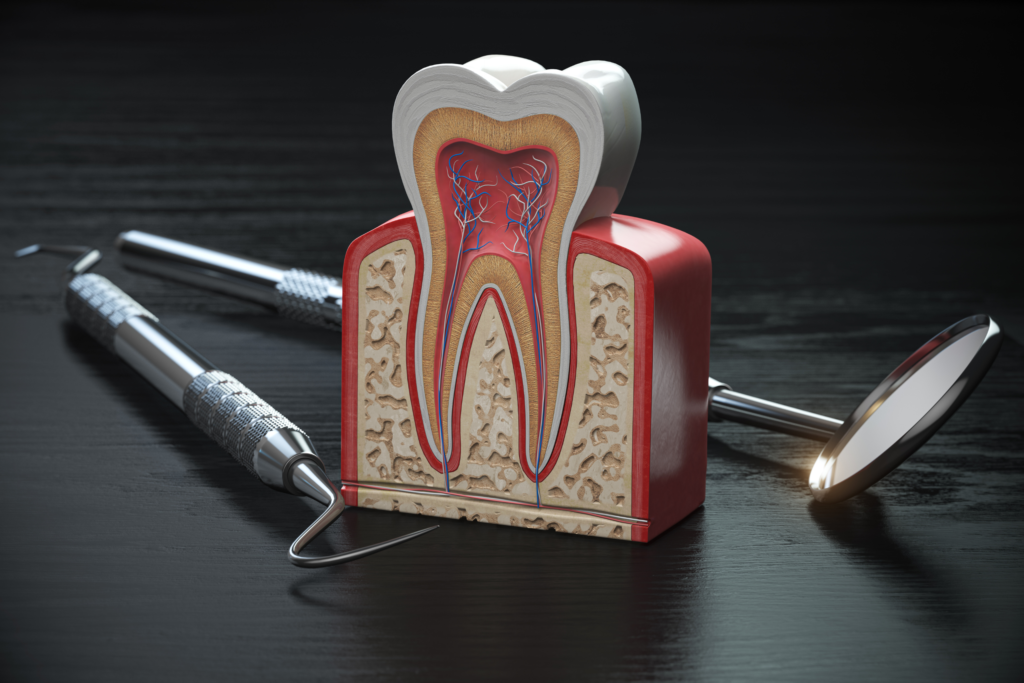
Save your tooth, restore your smile!
Root Canal Treatment in Knutsford
Root canal treatment is a highly effective procedure that removes infection and saves your natural tooth. With modern techniques, it’s now a comfortable, straightforward way to relieve pain and protect your dental health.
What is a root canal treatment?
A root canal treats the inside of a tooth when the pulp becomes infected or damaged. During the procedure, the infected tissue is removed, the inside of the tooth is cleaned and sealed, and a protective restoration is placed.
This treatment preserves your tooth and eliminates pain, helping you avoid extraction.

The process of a root canal treatment
1.
Assessment
Your dentist examines the tooth and takes X-rays to assess the extent of the infection.
2.
Anaesthesia
The area is numbed to ensure you’re comfortable throughout the procedure.
3.
Cleaning & Shaping
The infected pulp is removed, and the root canals are thoroughly cleaned and shaped.
4.
Filling & Restoration
The canals are sealed, and the tooth is protected with a filling or crown for added strength.
Signs you might need a root canal treatment
do you have any of these symptoms
- Persistent toothache or sensitivity to hot and cold.
- Swollen or tender gums around the affected tooth.
- Discolouration or darkening of the tooth.
- Pain when chewing or biting.
- A small, recurring bump on the gums near the tooth.
If you’re experiencing any of these symptoms, don’t wait – early treatment can save your tooth and prevent further complications.

Benefits of a root canal treatment
why root canals are worth it
Preserve your natural tooth: Avoid extractions and maintain your natural bite.
Relieve pain: Eliminate the discomfort caused by infection or inflammation.
Prevent further issues: Stop the spread of infection to surrounding teeth or gums.
A durable solution: With a crown or filling, your treated tooth can last a lifetime.

— frequently asked questions —
Quick answers to your questions
How long can a tooth wait for a root canal?
The timeframe for a root canal depends on the severity of the infection or damage. If the tooth is causing pain, swelling, or an abscess has formed, treatment should be sought immediately to prevent the infection from spreading. In some cases, a temporary filling can protect the tooth for a few weeks, but delaying too long may result in the need for extraction.
Is it better to have a root canal or extraction in the UK?
A root canal is often preferable to preserve the natural tooth, which maintains chewing efficiency, jawbone health, and alignment of surrounding teeth. However, extraction may be recommended if the tooth is too damaged or if saving it isn’t cost-effective.
At what point is it too late for a root canal?
A root canal may be too late if the tooth is severely decayed, the infection has spread extensively, or the tooth structure is too compromised to support a restoration. In such cases, extraction is typically the only viable option. Dentists evaluate the condition of the tooth and surrounding tissues before deciding.
What are signs you need a root canal?
Signs you may need a root canal include:
•Persistent tooth pain or sensitivity (especially to hot or cold).
•Swelling, tenderness, or abscess formation in the gums near the tooth.
•Discolouration of the tooth.
•Pain when biting or chewing.
If you experience any of these symptoms, consult a dentist promptly.
Does a root canal hurt?
Root canals are performed under local anaesthesia, making the procedure relatively painless. While mild discomfort or sensitivity may occur afterward, it is typically manageable with over-the-counter pain relief. Modern techniques make root canals far less intimidating than their reputation suggests.
Can rotting teeth be saved?
In many cases, rotting teeth can be saved with treatments like root canals, fillings, or crowns, provided the damage is not too extensive. Early intervention is crucial. If the decay reaches an advanced stage, extraction may be necessary. Dentists assess each case to recommend the best treatment option.
